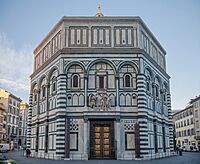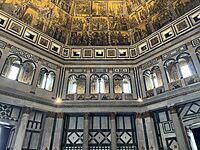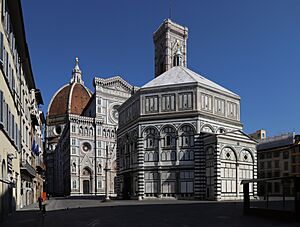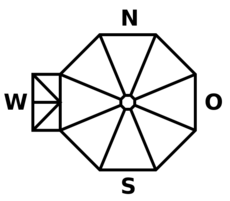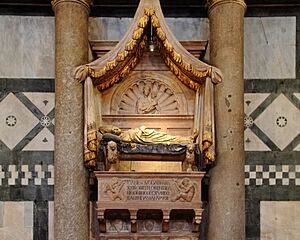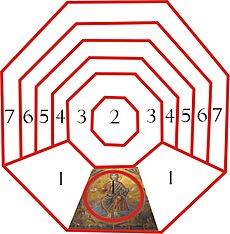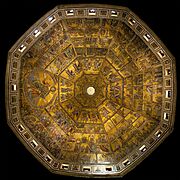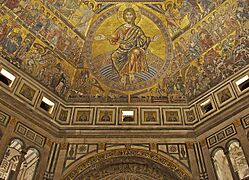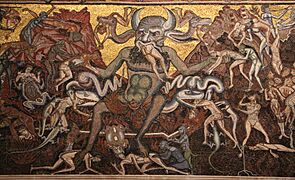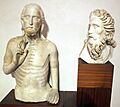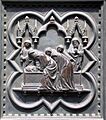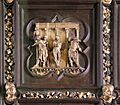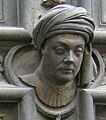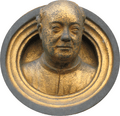Florence Baptistery facts for kids
Quick facts for kids Florence Baptistery |
|
|---|---|
| Baptistery of Saint John | |
|
|
|
Facade opposite Florence Cathedral
|
|
| 43°46′23″N 11°15′18″E / 43.77306°N 11.25500°E | |
| Location | Florence, Tuscany |
| Country | Italy |
| Denomination | Catholic Church |
| History | |
| Status | baptistery, minor basilica |
| Dedication | Saint John the Baptist |
| Architecture | |
| Style | Romanesque |
| Groundbreaking | 11th century |
| Specifications | |
| Length | 37.0 m (121.4 ft) |
| Width | 32.5 m (107 ft) |
| Height | 39 m (128 ft) |
| Materials | Marble, serpentinite, sandstone |
| Administration | |
| Archdiocese | Archdiocese of Florence |
The Florence Baptistery, also known as the Baptistery of Saint John (Italian: Battistero di San Giovanni), is a famous religious building in Florence, Italy. It is dedicated to John the Baptist, the patron saint of the city. A baptistery is a special building used for the Christian ceremony of baptism.
This building is one of the oldest in Florence and is known for its unique eight-sided shape, called an octagon. It stands in the city's main square, the Piazza del Duomo, right next to the famous Florence Cathedral. For centuries, almost every Catholic person from Florence was baptized here, including the famous poet Dante Alighieri.
The Baptistery is celebrated for its incredible art. It has three sets of huge bronze doors covered in detailed sculptures. The most famous set, the "Gates of Paradise," was so beautiful that the artist Michelangelo said they were fit for the entrance to heaven. Inside, the ceiling is covered in a stunning golden mosaic that tells stories from the Bible.
Contents
History of the Baptistery
For a long time, people in Florence believed the Baptistery was once an ancient Roman temple for the god Mars. However, modern studies and digging have shown this is not true. Experts now agree that the building was most likely built in the 11th or 12th century.
No one knows for sure who designed the Baptistery. Its style was inspired by ancient Roman buildings like the Pantheon, but it is also a very original creation. Its design was so impressive that it inspired later Renaissance architects like Filippo Brunelleschi.
Why is it an octagon?
The Baptistery has eight sides, a shape that was common for early Christian baptisteries. The number eight was symbolic. In Christian belief, the world was created in seven days. The "eighth day" represented a new beginning and eternal life, which is what baptism was thought to offer.
The building has a small rectangular section on its west side called a scarsella. This part holds the altar and gives the building a clear direction. The lantern, the small structure on top of the dome, was added around 1150.
The Baptistery's Exterior
The outside of the Baptistery is covered in beautiful geometric patterns made from white and green marble. The white marble came from Carrara, and the dark green stone came from a nearby town called Prato. The building has three large doorways, and its walls are decorated with arches and windows that look like those on ancient Roman buildings.
The "zebra stripes" on the corners were added later, around 1293, to match the new cathedral being built next to it. The two dark red columns next to the main doors were a gift from the city of Pisa in 1117. They were given to thank Florence for protecting Pisa during a war.
Originally, each of the three doorways had a group of statues above it. These statues are now kept in a museum, the Museo dell'Opera del Duomo, to protect them.
The Famous Bronze Doors
The Baptistery is most famous for its three huge sets of bronze doors. They are considered masterpieces of art. The original doors are now in a museum, and beautiful copies stand in their place at the Baptistery.
South Doors by Andrea Pisano

The first set of doors was made for the south entrance by the artist Andrea Pisano. He worked on them from 1330 to 1336. The doors are decorated with 28 panels inside a shape called a quatrefoil (like a four-leaf clover).
The top 20 panels show scenes from the life of John the Baptist. The bottom eight panels show figures representing important virtues like Hope, Faith, Justice, and Fortitude. Pisano's figures are small but look powerful and full of emotion.
North Doors by Lorenzo Ghiberti
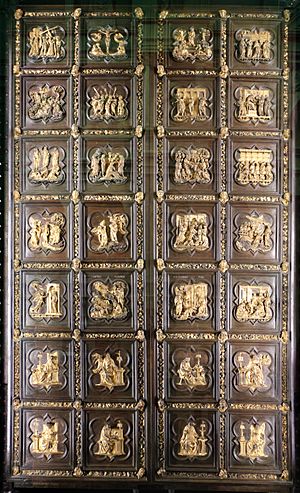
In 1401, the city held a competition to see who would create the next set of doors. Two young artists, Lorenzo Ghiberti and Filippo Brunelleschi, submitted amazing sample panels. Ghiberti won the competition, and this event is often seen as the start of the Renaissance in art.
Ghiberti and his workshop, which included famous artists like Donatello and Paolo Uccello, worked on the doors for over 20 years. These doors show 20 scenes from the life of Jesus Christ, from his birth to his resurrection. Ghiberti was an innovator, creating a sense of depth and three-dimensional space in his sculptures.
East Doors: The "Gates of Paradise"
Ghiberti's first set of doors was so successful that he was asked to make a third set. For these doors, he used a completely new design. Instead of 28 small panels, he created 10 large, square panels. This allowed him to create much more complex scenes.
These doors show stories from the Old Testament, such as the creation of Adam and Eve and the story of Moses. Ghiberti used new techniques like linear perspective to make the scenes look incredibly realistic and deep. The doors were so stunning that they were placed in the most important spot, facing the cathedral. The artist Michelangelo famously called them the "Gates of Paradise."
Inside the Baptistery
The inside of the Baptistery is just as amazing as the outside. The walls are covered in the same green and white marble patterns. The space feels huge and grand, much like the ancient Roman Pantheon.
Tombs and Monuments
The Baptistery holds several important tombs. One of the most famous is the tomb of Antipope John XXIII, created by the artists Donatello and Michelozzo. It was the first tomb of its kind during the Renaissance and features a life-like golden statue of the man resting under a canopy.
Another tomb belongs to Bishop Ranieri, who was the bishop of Florence when the Baptistery was being built in the late 11th and early 12th centuries.
The Mosaic Ceiling
The most breathtaking feature inside the Baptistery is the giant mosaic on the ceiling. Created between about 1240 and 1300, it is made of millions of tiny glass and stone tiles, many of them covered in gold. The mosaics glitter in the light and cover the entire dome.
The ceiling is divided into eight sections and tells several stories from the Bible.
- The Last Judgment: The largest and most dramatic section shows Christ deciding the fate of souls. On his right are the saved, who are welcomed into a peaceful Heaven. On his left are the damned, who are taken to a chaotic Hell filled with demons. This part was designed by artists like Coppo di Marcovaldo.
- Bible Stories: The other sections show stories from the Book of Genesis, the life of Joseph, the lives of Mary and Jesus, and the life of Saint John the Baptist.
- Famous Artists: Many famous artists of the time, possibly including Cimabue, worked on the designs for these mosaics.
The ceiling is a masterpiece of medieval art. It is currently being restored, a process that is expected to be finished around 2028.
- Views of the mosaic ceiling
Images for kids
-
A drawing of the Pantheon's interior by the artist Raphael.


